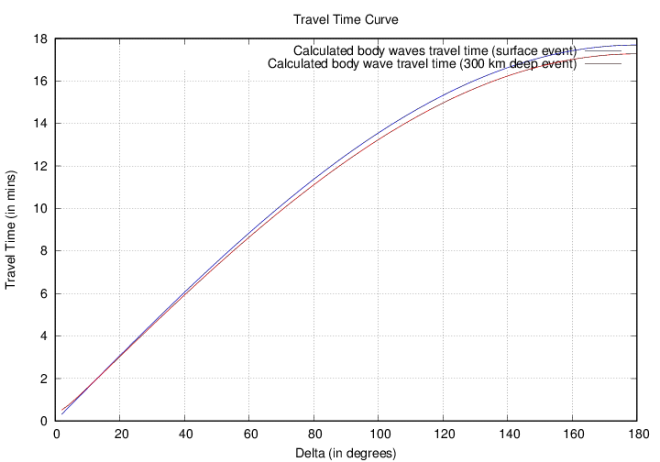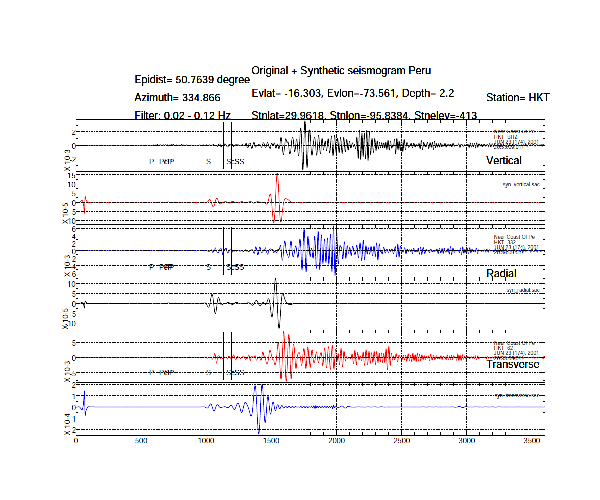A travel time curve is a graph of the time it takes a seismic ray to reach the station from an earthquake versus the distance of the earthquake to the station (epicentral distance).
Here, we calculate the travel time curve for a spherically homogeneous Earth. This means the seismic velocity is constant for the whole earth. We have considered the three cases,
- When the seismic ray travel through the body from the surface event to the station (body waves).
- When the seismic ray for a deeper event (300 km depth) reaches the station.
Fortran code for calculation of the Model:
program travel_time_calc
!Program to calculate seismic travel times in a spherical, homogeneous Earth.
implicit none
real, parameter :: pi = 2*asin(1.0), R = 6371 ! radius of Earth (km
real :: V, xx, h1, h, dx
integer, parameter :: n = 89
integer :: i
real(kind=16), allocatable, dimension(:) :: x, xrad, Di, Ti, Tim, Dhi, Thi, Thim
V = 12; ! assumed constant seismic wave velocity (km/s)
dx=2 !increment
allocate(x(0:n),xrad(0:n),Di(0:n),Ti(0:n),Tim(0:n),Dhi(0:n),Thi(0:n),Thim(0:n)) !allocating the size of the arrays
write(*,*) "Distance (in degrees)", " ","T-time surface (in mins)", " ", "T-time interior (in mins)"
open(1,file="Tcalc.dat")
xx=0
do i=0,n !do loop
x(i) = xx + dx !distance
xrad(i) = x(i)*pi/180 ! convert degrees to radians
!Path along the body
Di(i) = 2*R*sin(0.5*xrad(i)) ! distance of the surface event along the body in km
Ti(i) = Di(i)/V ! travel time in seconds
Tim(i) = Ti(i)/60 ! travel time in minutes
!For deeper events (300 km)
h1=300
h=R-h1
Dhi(i) = sqrt(R**2 + h**2 - 2*R*h*cos(xrad(i))) !distance of the interior events in km
Thi(i) = Dhi(i)/V ! travel time in seconds
Thim(i)= Thi(i)/60 ! travel time in minutes
write(1,10) x(i), Tim(i), Thim(i) !printing output on the terminal
write(*,10) x(i), Tim(i), Thim(i) !printing output on the terminal
xx = x(i)
end do
10 format(f7.2, " ",f8.4, " ",f8.4)
deallocate(x, xrad, Di, Ti, Tim, Dhi, Thi, Thim) ! deallocates the array
end program travel_time_calc
For the above program, we have considered the Earth to be isotropic and homogeneous with constant velocity of 12 km/s. Then we parameterize for 89 events each with 2 degrees interval from 2 to 180 degrees. The radius of the earth is assumed to be 6371 km.
For compiling and plotting (bash script):
#!/bin/bash
gfortran -ffree-form travel_time_calc.f -o travel_time_calc
./travel_time_calc
gnuplot << EOF
set terminal postscript color solid #terminal type
set title 'Travel Time Curve' #figure title
set xlabel 'Delta (in degrees)' #xlabel
set ylabel 'Travel Time (in mins)' #ylabel
set output 'travel_time.ps' #output fig name
set grid #grid
plot [:] [:] "Tcalc.dat" using 1:2 title "Calculated body waves travel time (surface event)" with lines lc rgb "blue", \
"Tcalc.dat" using 1:3 title "Calculated body wave travel time (300 km deep event)" with lines lc rgb "red"
EOF

– Utpal Kumar (IES, Academia Sinica)











